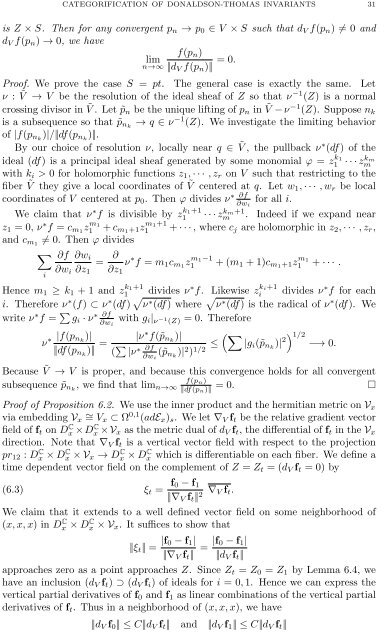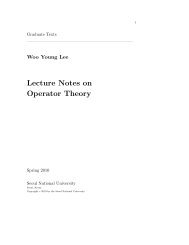Categorification of Donaldson-Thomas invariants via perverse ...
Categorification of Donaldson-Thomas invariants via perverse ...
Categorification of Donaldson-Thomas invariants via perverse ...
You also want an ePaper? Increase the reach of your titles
YUMPU automatically turns print PDFs into web optimized ePapers that Google loves.
CATEGORIFICATION OF DONALDSON-THOMAS INVARIANTS 31is Z × S. Then for any convergent p n → p 0 ∈ V × S such that d V f(p n ) ≠ 0 andd V f(p n ) → 0, we havef(p n )limn→∞ |d V f(p n )| = 0.Pro<strong>of</strong>. We prove the case S = pt. The general case is exactly the same. Letν : Ṽ → V be the resolution <strong>of</strong> the ideal sheaf <strong>of</strong> Z so that ν−1 (Z) is a normalcrossing divisor in Ṽ . Let ˜p n be the unique lifting <strong>of</strong> p n in Ṽ − ν−1 (Z). Suppose n kis a subsequence so that ˜p nk → q ∈ ν −1 (Z). We investigate the limiting behavior<strong>of</strong> |f(p nk )|/|df(p nk )|.By our choice <strong>of</strong> resolution ν, locally near q ∈ Ṽ , the pullback ν∗ (df) <strong>of</strong> theideal (df) is a principal ideal sheaf generated by some monomial ϕ = z k11 · · · zkm mwith k i > 0 for holomorphic functions z 1 , · · · , z r on V such that restricting to thefiber Ṽ they give a local coordinates <strong>of</strong> Ṽ centered at q. Let w 1, · · · , w r be localcoordinates <strong>of</strong> V centered at p 0 . Then ϕ divides ν ∗ ∂fi∂w ifor all i.We claim that ν ∗ f is divisible by z k1+11 · · · zm km+1 . Indeed if we expand nearz 1 = 0, ν ∗ f = c m1 z m11 + c m1+1z m1+11 + · · · , where c j are holomorphic in z 2 , · · · , z r ,and c m1 ≠ 0. Then ϕ divides∑ ∂f ∂w i=∂ ν ∗ f = m 1 c m1 z m1−11 + (m 1 + 1)c m1+1z m11 + · · · .∂w i ∂z 1 ∂z 1Hence m 1 ≥ k 1 + 1 and z k1+11 divides ν ∗ f. Likewise z ki+1i divides ν ∗ f for eachi. Therefore ν ∗ (f) ⊂ ν ∗ (df) √ ν ∗ (df) where √ ν ∗ (df) is the radical <strong>of</strong> ν ∗ (df). Wewrite ν ∗ f = ∑ g i · ν ∗ ∂f∂w iwith g i | ν −1 (Z) = 0. Thereforeν ∗ |f(p n k)||df(p nk )| = |ν ∗ f(˜p nk )|(∑( ∑ |ν ∗ ∂f∂w i(˜p nk )| 2 ) ≤ |gi (˜p 1/2 nk )| 2) 1/2−→ 0.Because Ṽ → V is proper, and because this convergence holds for all convergentf(psubsequence ˜p nk , we find that lim n)n→∞ ||df(p = 0.□n)||Pro<strong>of</strong> <strong>of</strong> Proposition 6.2. We use the inner product and the hermitian metric on V x<strong>via</strong> embedding V x∼ = Vx ⊂ Ω 0,1 (adE x ) s . We let ∇ V f t be the relative gradient vectorfield <strong>of</strong> f t on D C x ×D C x ×V x as the metric dual <strong>of</strong> d V f t , the differential <strong>of</strong> f t in the V xdirection. Note that ∇ V f t is a vertical vector field with respect to the projectionpr 12 : D C x × D C x × V x → D C x × D C x which is differentiable on each fiber. We define atime dependent vector field on the complement <strong>of</strong> Z = Z t = (d V f t = 0) by(6.3) ξ t = f 0 − f 1|∇ V f t | 2 ∇ V f t .We claim that it extends to a well defined vector field on some neighborhood <strong>of</strong>(x, x, x) in D C x × D C x × V x . It suffices to show that|ξ t | = |f 0 − f 1 ||∇ V f t |= |f 0 − f 1 ||d V f t |approaches zero as a point approaches Z. Since Z t = Z 0 = Z 1 by Lemma 6.4, wehave an inclusion (d V f t ) ⊃ (d V f i ) <strong>of</strong> ideals for i = 0, 1. Hence we can express thevertical partial derivatives <strong>of</strong> f 0 and f 1 as linear combinations <strong>of</strong> the vertical partialderivatives <strong>of</strong> f t . Thus in a neighborhood <strong>of</strong> (x, x, x), we have|d V f 0 | ≤ C |d V f t | and |d V f 1 | ≤ C |d V f t |













